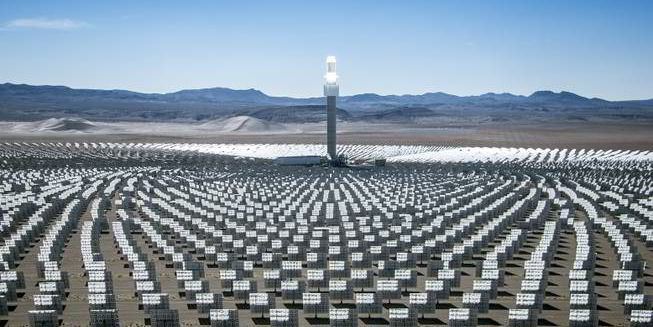The developer says its Sandstone Energy X project would be the world’s largest solar project and generate enough electricity to power about a million homes, most in neighboring California. SolarReserve has its headquarters there.
Nameplate capacity would be comparable to the iconic Hoover Dam outside Las Vegas or a large nuclear plant.
Chief executive Kevin Smith told the Las Vegas Review-Journal that the company will explore federal loan programs and private financing to underwrite cost of the massive facility. It has no customers yet for the proposed plant’s future electricity.
Solar Reserve anticipates that Sandstone Energy X will include the ability to employ "advanced molten salts" to store heat without batteries or backup fuels that would enable it to provide electricity during off-peak hours including at night.
The project will be free of CO2 emissions and hazardous waste, and utilize little water, which is increasingly scarce in the US southwest.
Smith told the newspaper that SolarReserve may be in position to announce the exact location in Nye County outside the city of Tonopah in 2017, with construction to begin by 2020. That would enable it to qualify for the 30% federal investment tax credit, which is scheduled to phase-down in value after then.
It will need to build high voltage transmission lines to carry the power to a connection with the grid operated by California Independent System Operator (CAISO).
Obtaining federal approvals for project and transmission line construction on public lands has been anything but easy under President Barack Obama, despite his outspoken support for renewable energy.
The process is bureaucratic, costly and sometimes duplicative as it involves multiple federal agencies with different agendas and regulatory requirements, which can result in years of delays. This has led developers to sometimes walk away from projects despite outstanding solar and wind resource on some public lands.
SolarReserve would like the eventual Sandstone X site to be near its 110MW Crescent Dunes CSP project outside Tonopah, which occupies about one-tenth the land as the larger project would occupy. .
According to the Associated Press, Crescent Dunes cost about $1bn and was backed by $737m in federal loan guarantees. NV Energy, part of billionaire Warren Buffett’s Berkshire Hathaway conglomerate, is buying Crescent’s output at 13.5 cents/kWh over 25 years.
The project's size and scope is certain to draw close scrutiny from environmentalists and wildlife groups, who are concerned with what they assert are large numbers of bird fatalities resulting from operations at the Ivanpah CSP facility in California and to some extent, Crescent
The birds are killed from collisions with the mirrors and central towers, or incinerated from the high-temperature beams of concentrated sunlight.
Smith told the newspaper that the issue is overblown, especially at Crescent, where biologists have recorded 60 bird deaths thus far.
"That's probably less than the office building we working out of in Santa Monica," he said, referring to the city where SolarReserve has its headquarters.

